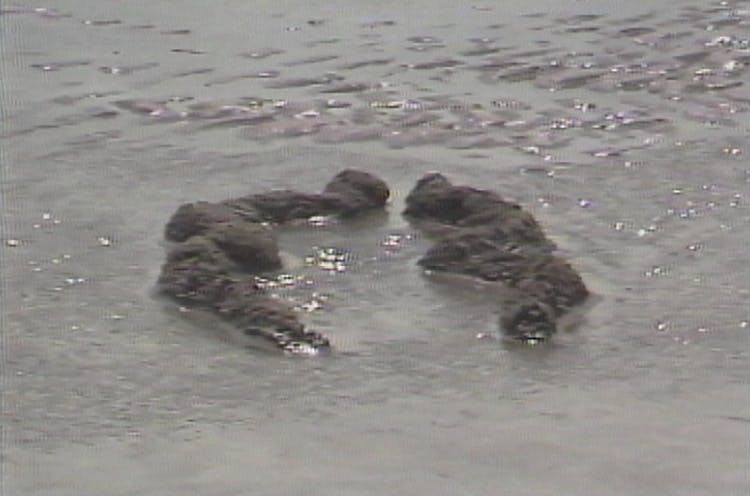
- Magazine Article
- Exhibitions
Ana Mendieta
An eight-minute video explores ideas of place and human identity

Ochún, 1981. Ana Mendieta (Cuban, 1948–1985). ¾-inch U-matic color video, sound; 8:30 min. © 2020 The Estate of Ana Mendieta Collection, LLC. Courtesy Galerie Lelong & Co. / Licensed by Artists Rights Society (ARS), New York
Cuban-born artist Ana Mendieta (1948–1985) began her eight-minute color video Ochún with a view of the ocean horizon on a sunny day. Seagulls and waves can be heard in the background. The setting is Key Biscayne, Florida, off the coast of Miami. In the opening moments, the camera pans to a formation in the water, a low wall seemingly fashioned of packed mud. The mud stands out in the surrounding landscape and is notably darker in color than the sand around it, suggesting that it was perhaps transported from another location.
The sun sparkles off the water surrounding the form. In the following moments, the camera cuts to another view of the mud formation, then another, then another, and another. The camera moves unsteadily in each shot, giving viewers the impression that the filmmaker is walking in and through the shallow water to capture the formation from all sides. Through these multiple camera angles, we begin to get a sense of the formation as a figure. Two packed, undulating walls of wet mud create the silhouette of a female body—the head, neck, bust, waist, and hips taking shape from the simple lines.
Ochún documents a sculpture from the Silueta (Silhouette) series—for which Mendieta is best known—that involved constructing abstract female forms using organic materials such as blood, soil, fire, and feathers. The video meditates on Mendieta’s experiences as an immigrant. In 1961, at age 12, she was separated from her family in Havana and sent to an orphanage in Iowa as part of a program for exiled children. Water, which dominates the video’s views and soundtrack, is presented as a uniting element that connects the United States and Cuba, evoking the artist’s hope to capture “the transition between my homeland and my new home . . . reclaiming my roots and becoming one with nature.”
The silhouette that is the central focus of the nonnarrative video is open at both the top and the bottom, and from each vantage point we can see that the water flows smoothly through its openings. Thus, rather than damming or interfering with the water’s movement, the silhouette is perfectly in line with it, existing in harmony with its surroundings in the serene ocean landscape.
In other photographs, films, and videos in the Silueta series, the artist alternates between featuring her actual body in various landscapes and impressions or outlines of her body. At times, her body can be seen beneath plants or layers of mud. Other times, when her body is absent, an impression in the earth or in shallow water is used to allude to Mendieta’s presence. In other instances, a bodily void is filled with flames or bright red pigment, suggesting violence. Themes of absence, origins, and concepts of life and death are prevalent throughout her Silueta series.
Over the course of Ochún’s eight-minute loop, the durational view of the beach reveals that the tide is slowly receding, and as viewers watch, the formation and the soft sand bed beneath it become more and more pronounced. We also realize that, given this orientation, Mendieta, as the camera holder, is standing on a Florida beach, facing out toward the horizon, toward Cuba. We are left to contemplate the gentle movement of the water beyond the frame, through the silhouette, flowing toward the artist’s homeland.
Mendieta explored issues of the body, earth, and place throughout her brief but influential career. The works in the Silueta series were the focus of most of the nearly 80 films that she created beginning in 1973, establishing her as one of the most prolific artists to take up the medium at the time. Completed just a few years before the end of her life, Ochún is the only project the artist shot on the newer medium of videotape.

Mendieta’s interdisciplinary training is evident in the wide range of her practice. Beyond video, she is well known for her photographs, sculptures, installations, and performances. Mendieta studied art at the University of Iowa in the 1970s with artist Hans Breder. The program was unique at the time in that it allowed for an intermedia focus rather than stipulating that students stay confined to a single medium (e.g., painting, sculpture, photography), and instructors let students interact with a broad array of practices.
While she was a student in 1973, she began visiting pre-Columbian archaeological sites in Mexico and the Caribbean and became interested in the history of displaced and diasporatic spiritual traditions, which paralleled her own history of exile and displacement. The title Ochún refers to a Yoruban deity associated with fertility and water. Historically, Yoruban spiritual practice was brought to the Americas by enslaved Africans, and it developed into a syncretic religion that draws from both Christian and West African sources.
This work is currently on view in the CMA’s Video Project Room, as a companion to the exhibition A Graphic Revolution: Prints and Drawings in Latin America.
Cleveland Art, Fall 2020